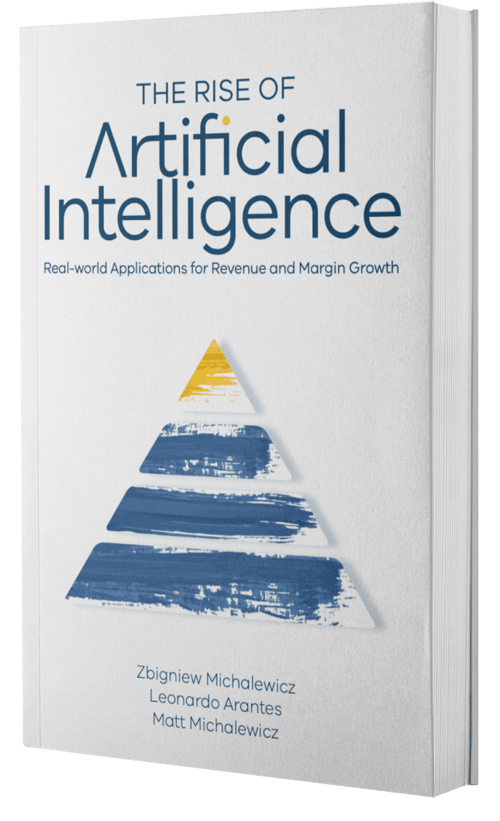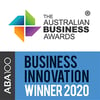The Rise of Artificial Intelligence is available for purchase in hard copy from Amazon, Booktopia, Readings, Dymocks, and other booksellers, as well as in ebook form.
Chapter 1: What is Artificial Intelligence?
This supplementary video to Chapter 1 of The Rise of Artificial Intelligence discusses the factors that have contributed to the rise of AI in recent times, along with exploration of the four research branches that attempt to replicate functions of the human body, such as vision, speech, movement, and thinking. An explanation of "algorithms" is provided, along with differentiation between AI- and non-AI algorithms and a demonstration of Ant Algorithms, followed by a discussion on why AI is important for any modern business manager or executive.
Click here to download Chapters 1 & 2 of The Rise of Artificial Intelligence: Real-world applications for revenue and margin growth, and please contact us to request a soft copy of any other chapter of the book.

Transcript (reading time: 14 min)
[00:00:06]
Hi, this is Matt Michalewicz, I'm one of the co-authors of The Rise of Artificial Intelligence, and this is a supplementary video to chapter one of the book. In this video we'll discuss the factors that have propelled Artificial Intelligence to the level of popularity and prominence that it enjoys today, as well as look into the four branches of AI research and show how each branch attempts to replicate a function of the human body. We'll also take a look into what algorithms are and the difference between AI algorithms and non-AI algorithms.
[00:00:38]
And lastly, we'll explain why this information is important for any modern business manager or executive in today's world. So why now? Artificial intelligence is not new. In fact, it’s a research field that stretches back 75 years in time. And yet if we look at statistics such as the amount of scientific papers published each year on the topic, we can see a 10x increase during the past 20 years. We can see similar growth curves in the amount of startup companies being created each year to develop AI systems and more tellingly, the amount of investment in billions of dollars that venture capitalists are pouring into AI companies.
[00:01:17]
Even if we just look at the revenue generated from Artificial Intelligence software applications, we can observe similar growth rates. So why now? What's happened over the last 5 -10 years that's propelled Artificial Intelligence out of obscurity and into the mainstream and our everyday vocabulary? The answer lies in six factors that have acted as tailwinds for Artificial Intelligence research and converged to popularise the subject and make it part of our everyday vocabulary.
[00:01:52]
The first of these six factors is computing power. Not many people realise that we’ve experienced a trillion fold increase in computing power since the 1950s, making any modern desktop or even mobile phone more powerful than all of NASA's computers when they put the first man on the moon. This has been very important for the field of artificial intelligence because AI is a computationally hungry type of technology, meaning that any advancement in computing power and computing affordability translates into advancements in algorithmic performance and usability of AI in the real world.
[00:02:30]
The second factor and tailwind has to do with the algorithms themselves. Over time, scientists have improved the results that AI algorithms generate on well-known problems, like recognising faces or turning speech into text. And better algorithmic performance translates into more awareness and respect for the field of Artificial Intelligence, as well as greater commercial applicability. The third factor has been the growing availability of training data, which has largely coincided with the explosion of Internet data. There are now trillions of web pages containing digital text, images and videos, all of which can be used by AI algorithms for training purposes.
[00:03:15]
This is an important point, because Artificial Intelligence is a type of technology that, like the human brain, can learn from experience and past data. And hence, if there is a lack of training data, then we might be limited in our ability to properly train these algorithms, which might compromise the results we can achieve on real world problems. As the amount of training data increases, our ability to properly train these algorithms also increases, which enables us to generate better results.
[00:03:48]
Skills availability has been the fourth factor, along with knowledge dissemination. It might surprise you to learn that the three of the most in demand skills in the United States are all related to Artificial Intelligence, in the areas of machine learning, deep learning and natural language processing. This is important because if you wanted to undertake an Artificial Intelligence project 20 or 30 years ago, you would have gone to a university into a computer science department, which is just about the only place where such skills and knowledge existed. Today, the widespread dissemination of AI skills and the knowledge has enabled organisations of all shapes and sizes to undertake AI projects that just wouldn’t have been possible without these skills being available.
[00:04:37]
The fifth factor has been digitalisation, which is the conversion of analog information and data, as well as manual business processes and workflows, into digital formats. Again, this has been a vital tailwind for Artificial Intelligence research because you can't apply AI to pen and paper and whiteboards. Artificial Intelligence is a digital technology and requires digital inputs. And as more and more organisations embarked upon digitalisation projects, they created the foundation necessary for more advanced technologies and projects, thereby making AI more accessible.
[00:05:20]
And lastly, there's been the pressure of capitalism itself, as the easy gains in business have already been made. The world today is faster, more complex and noisier than ever before, requiring a new level of sophistication and technology. Hence, it's no surprise to read quotes such as this: 84% of enterprises believe investing in AI will lead to greater competitiveness. In fact, many executives believe that not having AI in their business will be a source of competitive disadvantage in the future. So those are the factors that have propelled Artificial Intelligence forward.
[00:06:01]
But what exactly is Artificial Intelligence? The easiest way to think about the field is as our attempt as a species to replicate ourselves artificially. And for that reason, there is a direct parallel between Artificial Intelligence research and the human body. With our ultimate goal or dream being something like Data from Star Trek: The Next Generation: an android that was self-aware and that exhibited all of the functions of the human body, the ability to move, to see, to speak, to hear, and of course, to think. And this is the reason why Artificial Intelligence can be neatly divided into four branches of research, with each branch attempting to replicate a function of the human body.
[00:06:46]
The first branch is robotics, which attempts to replicate mechanical movement. Robotics in particular has revolutionised the manufacturing industry, bringing an enormous amount of automation to modern production and assembly plants. Robots today are also more agile. They're able to fold clothes, make coffee, even train other robots how to do tasks, thereby removing humans from the equation altogether. The second branch of Artificial Intelligence research is computer vision, which attempts to replicate the visual system of the human body. Major application areas include security. Imagine subways, airports, military facilities, and stadiums, all with tens of thousands of people that need to be monitored with hundreds or thousands of CCTV cameras.
[00:07:38]
This is an ongoing area of computer vision research, trying to develop algorithms that can automatically analyse moving imagery and in real time detect suspicious activities. Another major application area includes medical devices and medical imaging. What a pathologists do in a lab, in terms of looking at biological samples on petri dishes and making a decision on whether it's malignant or benign , can now being done by machines. And these machines are based on computer vision algorithms, with performance that has exceeded that of human experts in some cases.
[00:08:14]
This chart shows the results of a well-known international competition for object detection, and the crossover point just after 2014 between AI performance and human performance. The crossover is largely attributable to increases in algorithmic performance, as well as greater availability of digital training data for these algorithms.
[00:08:36]
The third branch of Artificial Intelligence research is called natural language processing, which attempts to replicate human speech and communication. If you've ever interacted with an application like Siri, or Google Home, or Alexa, then you've interacted with the natural language processing algorithm. These algorithms attempt to convert acoustic speech into digital text, analyse it for meaning, and then execute your command or answer your question. If you're a regular Siri user, you might be disappointed with how often Siri gets your commands wrong, or how often it misunderstands you. This is from a company, Apple, that is worth about a trillion dollars in market capitalisation and employs some of the best minds in the world in the field of natural language processing.
[00:09:26]
It just goes to show how difficult these problems are and the huge gap that still exists between the performance of the biological system – in this case our daily speech and communication with friends and family – and state-of-the-art algorithms. Major application areas of natural language processing include not only consumer devices, but also commercial applications in areas such as call centres where enormous efficiencies can be realised in terms of labour and speed by automating customer interactions.
[00:10:01]
And the last branch of artificial intelligence research is cognitive computing, which attempts to replicate brain functions like reasoning, deduction, inference, pattern recognition, and of course decision making. This is the most difficult area of Artificial Intelligence research, because it attempts to replicate artificially something that's still a mystery. In fact, many physicists have publicly said that the human brain is the most complicated object in the known universe. If we take space stations, nuclear power plants, black holes and supernovas, the human brain is the most complicated of them all.
[00:10:40]
Hence, we don’t really have a good understanding of how the human brain works, and it’s immensely difficult for AI scientists to replicate something we don’t understand. In fact, some scientists doubt that we'll ever be able to understand the human brain. And for that reason, we'll never be able to replicate it artificially, making humans somewhat unique. That said, major applications areas of cognitive computing algorithms include systems for decision making, driverless cars, and other problems where the interpretation and analysis of complex data and information is required.
[00:11:17]
This is also a good place to differentiate between General AI and Narrow AI, with General AI being the original dream of Artificial Intelligence, creating something like Data from Star Trek that is self-aware, conscious, and can replicate all of the functions of the human body. Today, that dream is still firmly planted in the realm of science fiction. This book is not about general AI and neither are the remaining chapters and videos. What this book and video series is about is narrow AI, which is the application of Artificial Intelligence to very specific business problems, or narrow problems, where we can create real commercial outcomes, such as increased revenue, reduced costs, improved margins, greater customer engagement, greater competitiveness, and so on.
[00:12:04]
This is also a very good place talk about algorithms because Artificial Intelligence applications are always based on algorithms. So what are algorithms? The easiest way to think about them is as a set of instructions for taking inputs and converting them into outputs. People without a background in mathematics or computer science can often relate to a cooking recipe analogy, because cooking recipes can be thought of as algorithms. We have inputs, which are ingredients, we have a set of instructions of how to mix the ingredients, bake them at a certain temperature and so on. And then they have an output, which is whatever we're cooking: lasagne, or a cake, and so on.
[00:12:45]
Shown here is a simple algorithm for adding two numbers together. We start the algorithm, request the first number, second number, add the numbers, display the sum, and then stop. Of course, this algorithm has nothing to do with Artificial Intelligence and is incredibly simplistic, but illustrates the point that algorithms convert inputs into outputs by following a set of instructions.
[00:13:18]
The difference between a non-AI algorithm such as this one and an AI algorithm, is that Artificial Intelligence algorithms attempt to mimic natural processes and are almost always inspired by nature. You might have heard of neural networks or deep learning. Both of these types of Artificial Intelligence algorithms are based on the neuron/synapse structure of the human brain. They're inspired by biological processes, whereas non-AI algorithms are not. Non-AI algorithms usually rely on classical math formulas and equations that have been around for centuries and have very little to do with any biological system. Within Chapter 1 of the book, we gave an example of ant algorithms and explained how they attempt to mimic the behaviour of real ants in the real world, and we used them as an example of an AI algorithm.
[00:14:05]
Here we’ll play an actual video of ants moving from the bottom of the screen to the top and then back. The reason they move up and down is because their nest is at the bottom and a food source is at the top. And as they begin to move, you’ll also see they have a choice between taking the short path or the long path. What the ants don't know is which is which. There's no way for them to communicate: there are no street signs, no stop watches, no mobile phones. And yet over time, if you look at this part of the screen, you'll see these ants actually beginning to turn back and get onto the shorter path.
[00:14:41]
Somehow, through biological process that ants have developed over time, they’ve managed to figure out the how to find the shortest path between two points over complex terrain. It's an entirely natural phenomenon, and one that has nothing to do with technology. And in fact, ants have been around longer than we have as a species. Now, computer scientists look at this natural phenomenon and they immediately realise there are a lot of commercial problems in areas such as distribution, logistics, journey planning and so on, where finding the shortest distance or fastest time could create business value.
[00:15:21]
Keeping that in mind, AI scientists then create artificial ants, which is a type of AI algorithm. And they train these artificial ants to find the shortest path between a variety of different points, just like real ants would do in nature, before embedding them into software applications that deal with real assets: airplanes, cargos, cars, people, whatever the case might be. And then these algorithms are used to find the shortest distance, fastest time, and so on.
[00:15:55]
The important point here is that AI algorithms are almost always inspired by natural processes and biological phenomena, whereas non-algorithms are not. The second thing to point out is that the only reason we can build an effective ant algorithm is because we understand how real ants find the shortest path between two points, which is by laying down pheromone trails. And it's only because we understand this biological mechanism, the process by which this works, that computer scientists can replicate it artificially in a computing environment.
[00:16:38]
If we didn't know the mechanism, then we couldn't create an ant algorithm. And this is the whole problem with the dream of Artificial Intelligence and our attempt in replicating the human brain. We don't understand how the brain works, and without understanding it, it's difficult – some people say impossible –to replicate it artificially. So, in summary, we can think of the entire field of Artificial Intelligence as these four pillars of research – robotics, computer vision, natural language processing and cognitive computing – each of which represent a function of the human body that we're trying to replicate. Whereas the algorithmic areas of research cut horizontally across all areas, because algorithms like deep learning, or neural networks can be used in any of these problem domains. Speaking of which, machine learning algorithms and methods like deep learning, form a subset of the overall Artificial Intelligence algorithms that are researched across these various problem types.
[00:17:33]
So why is all this important? The reason is because the world has reached a level of speed, complexity and noise where no one can really assess and process all of the available data and information when making decisions. This is a problem because good decisions create value. If you want to positively impact some of business metrics, such as improving margin, customer engagement, revenue growth, return on sales and marketing spend and so on, you can do it through the quality of decisions that you and your staff make within an organisation.
[00:18:06]
If we make high quality decisions consistently over long stretches of time, we will impact these metrics in a positive way and create value for the organisation and its shareholders. If, on the other hand, we consistently make bad decisions, we will destroy value over time. And Artificial Intelligence is uniquely suited to improve the decision-making capability of most organisations, particularly when we consider the fact that making good decisions isn't easy. Most people don't wake up in the morning intuitively knowing through some process of osmosis what the best decision is for every problem they'll encounter that day. We just don't know.
[00:18:58]
Making good decisions is difficult, and there is a direct parallel between Artificial Intelligence capability and organisation's decision-making capabilities, which will be the subject of the next chapter and the next video.
"Larry will be our digital expert that will enable our sales team and add that technological advantage that our competitors don't have."
Kerry Smith
CEO, PFD Foods
$1.6 billion in revenue 
"Lion is one of Australasia’s largest food and beverage companies, supplying various alcohol products to wholesalers and retailers, and running multiple and frequent trade promotions throughout the year. The creation of promotional plans is a complicated task that requires considerable expertise and effort, and is an area where improved decision-making has the potential to positively impact the sales growth of various Lion products and product categories. Given Complexica’s world-class prediction and optimisation capabilities, award-winning software applications, and significant customer base in the food and alcohol industry, we have selected Complexica as our vendor of choice for trade promotion optimisation."
Mark Powell
National Sales Director, Lion
"At Liquor Barons we have an entrepreneurial mindset and are proud of being proactive rather than reactive in our approach to delivering the best possible customer service, which includes our premier liquor loyalty program and consumer-driven marketing. Given Complexica’s expertise in the Liquor industry, and significant customer base on both the retail and supplier side, we chose Complexica's Promotional Campaign Manager for digitalizing our spreadsheet-based approach for promotion planning, range management, and supplier portal access, which in turn will lift the sophistication of our key marketing processes."
Richard Verney
Marketing Manager
Liquor Barons

"Dulux is a leading marketer and manufacturer of some of Australia’s most recognised paint brands. The Dulux Retail sales team manage a diverse portfolio of products and the execution of our sales and marketing activity within both large, medium and small format home improvement retail stores. We consistently challenge ourselves to innovate and grow and to create greater value for our customers and the end consumer. Given the rise and application of Artificial Intelligence in recent times, we have partnered with Complexica to help us identify the right insight at the right time to improve our focus, decision making, execution, and value creation."
Jay Bedford
National Retail Sales Manager
Dulux

"Following a successful proof-of-concept earlier this year, we have selected Complexica as our vendor of choice for standardizing and optimising our promotional planning activities. Complexica’s Promotional Campaign Manager will provide us with a cloud-based platform for automating and optimising promotional planning for more than 2,700 stores, leading to improved decision-making, promotional effectiveness, and financial outcomes for our retail stores."
Rod Pritchard
Interim CEO, Metcash - Australian Liquor Marketers
$3.4 billion in revenue 
"After evaluating a number of software applications and vendors available on the market, we have decided to partner with Complexica for sales force optimisation and automation. We have found Complexica’s applications to be best suited for our extensive SKU range and large set of customers, being capable of generating recommendations and insights without burdening our sales staff with endless data analysis and interpretation.
Aemel Nordin
Managing Director, Polyaire
"DuluxGroup is pleased to expand its relationship with Complexica, a valued strategic partner and supplier to our business. Complexica’s software will enable DuluxGroup to reduce the amount of time required to generate usable insights, increase our campaign automation capability, personalise our communications based on core metrics, and close the loop on sales results to optimise ongoing digital marketing activity."
James Jones
Group Head of CRM, DuluxGroup
"Instead of hiring hundreds of data scientists to churn through endless sets of data to provide PFD with customer-specific insights and personalised recommendations, Larry, the Digital Analyst® will serve up the answers we need, when we need them, on a fully automated basis without the time and manual processes typically associated with complex analytical tasks.”
Richard Cohen
CIO, PFD Foods
$1.6 billion in revenue 
"As a global innovator in the wine industry, Pernod Ricard Winemakers is always seeking ways to gain efficiencies and best practices across our operational sites. Given the rise of Artificial Intelligence and big data analytics in recent times, we have engaged Complexica to explore how we can achieve a best-in-class wine supply chain using their cloud-based software applications. The engagement is focused on Australia & New Zealand, with a view to expand globally."
Brett McKinnon
Global Operations Director, Pernod Ricard Winemakers
"70% - 80% of what we do is about promotional activity, promotional pricing -- essentially what we take to the marketplace. This is one of the most comprehensive, most complex, one of the most difficult aspect of our business to get right. With Complexica, we will be best in class - there will not be anybody in the market that can perform this task more effectively or more efficiently than we can."
Doug Misener
CEO, Liquor Marketing Group
1,400+ retail stores 
"The key thing that makes such a difference in working with Complexica is their focus on delivering the business benefits and outcomes of the project."
Doug Misener
CEO, Liquor Marketing Group
1,400+ retail stores 
"Australia needs smart technology and people, and it has been a great experience for me to observe Complexica co-founders Zbigniew and Matt Michalewicz assemble great teams of people using their mathematical, logic, programming, and business skills to create world-beating products. They are leaders in taking our bright graduates and forging them into the businesses of the future."
Lewis Owens
Chairman of the Board, SA Water 
"Having known the team behind Complexica for some years ago now, I am struck by their ability to make the complex simple - to use data and all its possibilities for useful purpose. They bring real intelligence to AI and have an commercial approach to its application."
Andrew McEvoy
Managing Director, Fairfax Media - Digital 
"I have worked with the team at Complexica for a number of years and have found them professional, innovative and have appreciated their partnership approach to delivering solutions to complex problems."
Kelvin McGrath
CIO, Asciano 
“Working with Complexica to deliver Project Automate has been a true partnership from the initial stages of analysis of LMG’s existing processes and data handling, through scoping and development phase and onto delivery and process change adoption. The Complexica team have delivered considerable value at each stage and will continue to be a valued partner to LMG."
Gavin Saunders
CFO, Liquor Marketing Group 
“Complexica’s Order Management System and Larry, the Digital Analyst will provide more than 300 Bunzl account managers with real-time analytics and insights, to empower decision making and enhanced support. This will create more time for our teams to enable them to see more customers each day and provide the Bunzl personalised experience.”
Kim Hetherington
CEO, Bunzl Australasia 
"The team behind Complexica develops software products that are at the cutting edge of science and technology, always focused on the opportunities to deliver a decisive competitive edge to business. It has always been a great experience collaborating with Matthew, Zbigniew and Co."
Mike Lomman
GM Demand Chain, Roy Hill Iron Ore 
"The innovations that the Complexica team are capable of continue to amaze me. They look at problems from the client side and use a unique approach to collaborating with and deeply understanding their customers challenges. This uniquely differentiates what they bring to market and how they deliver value to customers."
John Ansley
CIO, Toll Group 
"Rather than building out an internal analytics team to investigate and analyse countless data sets, we have partnered with Complexica to provide our sales reps with the answers they need, when they need them, on a fully automated basis. We are excited about the benefits that Larry, the Digital Analyst will deliver to our business.”
Peter Caughey
CEO, Coventry Group 
“Complexica’s Order Management System and Larry, the Digital Analyst will provide more than 300 Bunzl account managers with real-time analytics and insights, to empower decision making and enhanced support. This will create more time for our teams to enable them to see more customers each day and provide the Bunzl personalised experience.”
Kim Hetherington
CEO, Bunzl Australasia 
"After an evaluation process and successful proof-of-concept in 2016, we have chosen to partner with Complexica to upgrade the technological capability of our in-field sales force. The next-generation Customer Opportunity Profiler provided by Complexica will serve as a key tool for sales staff to optimise their daily activities, personalise conversations and interactions with customers, and analyse data to generate actionable insights."
Stephen Mooney
Group Sales Capability Manager, DuluxGroup
$1.7 billion in revenue
"After evaluating a number of software systems available in the marketplace, we have ultimately selected Complexica as our vendor of choice for sales force automation and CRM. Given the large SKU range we carry and very long tail of customers we serve, Complexica’s applications are best suited to deal with this inherent complexity without burdening our staff with endless data entry."
Nick Carr
CEO, Haircaire Australia
Australia's largest distributor of haircare products
“Asahi Beverages is Australia’s largest brewer, supplying a leading portfolio to wholesalers and retailers, including some of Australia’s most iconic brands. Last year Asahi Beverages acquired Carlton & United Breweries, which is its Australian alcohol business division. To harness the strength of our expanded portfolio, we partner with our customers to run multiple and frequent trade promotions throughout the year, delivering long-term growth for both our business and theirs. Given the inherent complexity in optimising promotional plans and our continued focus on revenue and growth management, we have selected Complexica as our vendor of choice after a successful Proof-of-Concept of its world-class optimisation capabilities.”
Kellie Barnes
Group Chief Information Officer
Asahi Beverages
"Dulux is a leading marketer and manufacturer of some of Australia’s most recognised paint brands. The Dulux Retail sales team manage a diverse portfolio of products and the execution of our sales and marketing activity within both large, medium and small format home improvement retail stores. We consistently challenge ourselves to innovate and grow and to create greater value for our customers and the end consumer. Given the rise and application of Artificial Intelligence in recent times, we have partnered with Complexica to help us identify the right insight at the right time to improve our focus, decision making, execution, and value creation."
Jay Bedford
National Retail Sales Manager, DuluxGroup
"At Liquor Barons we have an entrepreneurial mindset and are proud of being proactive rather than reactive in our approach to delivering the best possible customer service, which includes our premier liquor loyalty program and consumer-driven marketing. Given Complexica’s expertise in the Liquor industry, and significant customer base on both the retail and supplier side, we chose Complexica's Promotional Campaign Manager for digitalizing our spreadsheet-based approach for promotion planning, range management, and supplier portal access, which in turn will lift the sophistication of our key marketing processes."
Richard Verney
Marketing Manager, Liquor Barons































